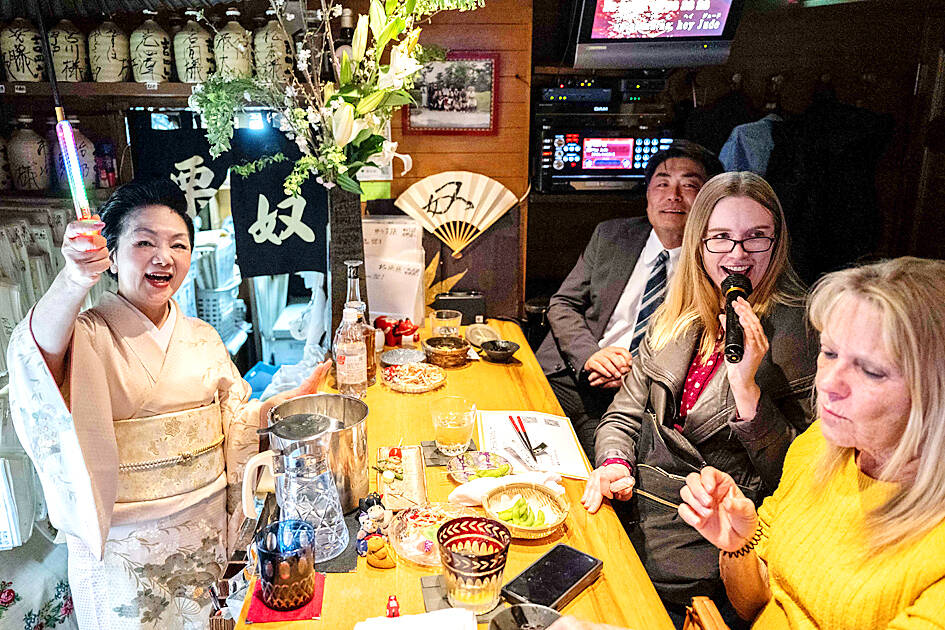Down a Tokyo street lined with bright signs, up narrow stairs and behind a windowless door is a “snack bar” long cherished by regulars but hidden from tourists — until now.
Snack bars are cozy, retro establishments found across Japan, often crammed into small buildings and equipped with karaoke systems that echo late into the night.
They are typically run by a woman nicknamed “mama” who chats to customers while serving drinks with nibbles such as nuts, dried squid or simple cooked dishes.

Photo: AFP
Despite being a fixture of Japanese nightlife since the post-war era, the tucked-away bars’ tight space can be intimidating, especially for people who do not speak the language.
So one company is offering guided tours to snack bars like Kuriyakko, in the capital’s Shimbashi business district.
Inside, dim lights reflect warmly off the red wall tiles, illuminating an art-deco poster as an American family belts out Hey Jude and Take Me Home, Country Roads.
Nora, who used to live in Japan, said she booked the tour for her parents, sister, aunt and uncle after seeing it on Instagram.
“I’ve always seen the signs for snack bars, but I wasn’t sure of how to enter them, or what to do,” said the 30-year-old, who is now based in San Francisco and did not want her surname published.
“My family hasn’t really been in Japan very often, so it was a good opportunity to get a real experience of the bar culture” in a “jovial” and “intimate” way,” she said.
‘KANPAI’
A guide from tour company Snack Yokocho teaches the group how to order whiskey highballs and plum wine in Japanese, and how to say “cheers” — “kanpai.”
Behind the bar, dressed in a smart pale kimono with her hair in a traditional updo, is “mama” Kuri Awaji, who has run Kuriyakko for 25 years.
It is one of about 100,000 snack bars in Japan, according to Snack Yokocho, and while most are run by women, some have a male “master.”
Although the atmosphere is less sexually charged than at modern host and hostess clubs, with the focus on convivial conversation, the history of snack bars is rooted in Japan’s red-light districts.
After World War II, some women turned to sex work to survive, but anti-prostitution laws were introduced at the time of the 1964 Olympics, Snack Yokocho representative Mayuko Igarashi said.
So to make money, they “took a simple wooden box to the regular street and served drinks and snacks.”
Little by little, these early snack bars moved indoors to small premises that the women could manage without having to prepare elaborate dishes.
Many were divorced and raising children alone, hence the “mama” nickname, Igarashi said.
“It was difficult for them to work during the day when the children were around, so after they went to bed, women stood at the counter to work in the evening,” she said.
FACE-TO-FACE
It is believed there were 200,000 snack bars in Japan in the 1950s and 60s, Igarashi said, but the number has declined as the operators retire or sell up.
Now with record numbers of tourists visiting Japan, Snack Yokocho said interest in its tours is growing.
As well as classic spots like Kuriyakko, the company’s guides bring visitors to themed snack bars such as a golf bar with a makeshift putting green.
It also sometimes runs tours for Japanese women who want to experience snack bar culture, but have reservations about knocking on a closed door alone.
For years, the bars’ clientele was almost exclusively men, Igarashi said.
However, as more women have joined the workforce, snack bars have become a “place for them to relax, or talk to ‘mama’ about their problems.”
People tend to talk on social media, but after a bad day, nothing beats face-to-face communication, she added.
“At a snack bar, people can look into each others’ eyes, and get to know each other very quickly — even strangers,” Igarashi said.

When Shanghai-based designer Guo Qingshan posted a vacation photo on Valentine’s Day and captioned it “Puppy Mountain,” it became a sensation in China and even created a tourist destination. Guo had gone on a hike while visiting his hometown of Yichang in central China’s Hubei Province late last month. When reviewing the photographs, he saw something he had not noticed before: A mountain shaped like a dog’s head rested on the ground next to the Yangtze River, its snout perched at the water’s edge. “It was so magical and cute. I was so excited and happy when I discovered it,” Guo said.

TURNAROUND: The Liberal Party had trailed the Conservatives by a wide margin, but that was before Trump threatened to make Canada the US’ 51st state Canada’s ruling Liberals, who a few weeks ago looked certain to lose an election this year, are mounting a major comeback amid the threat of US tariffs and are tied with their rival Conservatives, according to three new polls. An Ipsos survey released late on Tuesday showed that the left-leaning Liberals have 38 percent public support and the official opposition center-right Conservatives have 36 percent. The Liberals have overturned a 26-point deficit in six weeks, and run advertisements comparing the Conservative leader to Trump. The Conservative strategy had long been to attack unpopular Canadian Prime Minister Justin Trudeau, but last month he

Chinese authorities said they began live-fire exercises in the Gulf of Tonkin on Monday, only days after Vietnam announced a new line marking what it considers its territory in the body of water between the nations. The Chinese Maritime Safety Administration said the exercises would be focused on the Beibu Gulf area, closer to the Chinese side of the Gulf of Tonkin, and would run until tomorrow evening. It gave no further details, but the drills follow an announcement last week by Vietnam establishing a baseline used to calculate the width of its territorial waters in the Gulf of Tonkin. State-run Vietnam News

THIRD ANNIVERSARY OF WAR: Ursula von der Leyen said that Europe was in Kyiv because ‘it is not only the destiny of Ukraine that is at stake. It’s Europe’s destiny’ A dozen leaders from Europe and Canada yesterday visited Ukraine’s capital to mark the third anniversary of Russia’s invasion in a show of support for Kyiv by some of its most important backers. European Commission President Ursula von der Leyen and Canadian Prime Minister Justin Trudeau were among the visitors greeted at the railway station by Ukrainian Minister of Foreign Affairs Andrii Sybiha and the president’s chief of staff Andrii Yermak. Von der Leyen wrote on social media that Europe was in Kyiv “because Ukraine is in Europe.” “In this fight for survival, it is not only the destiny of Ukraine that is